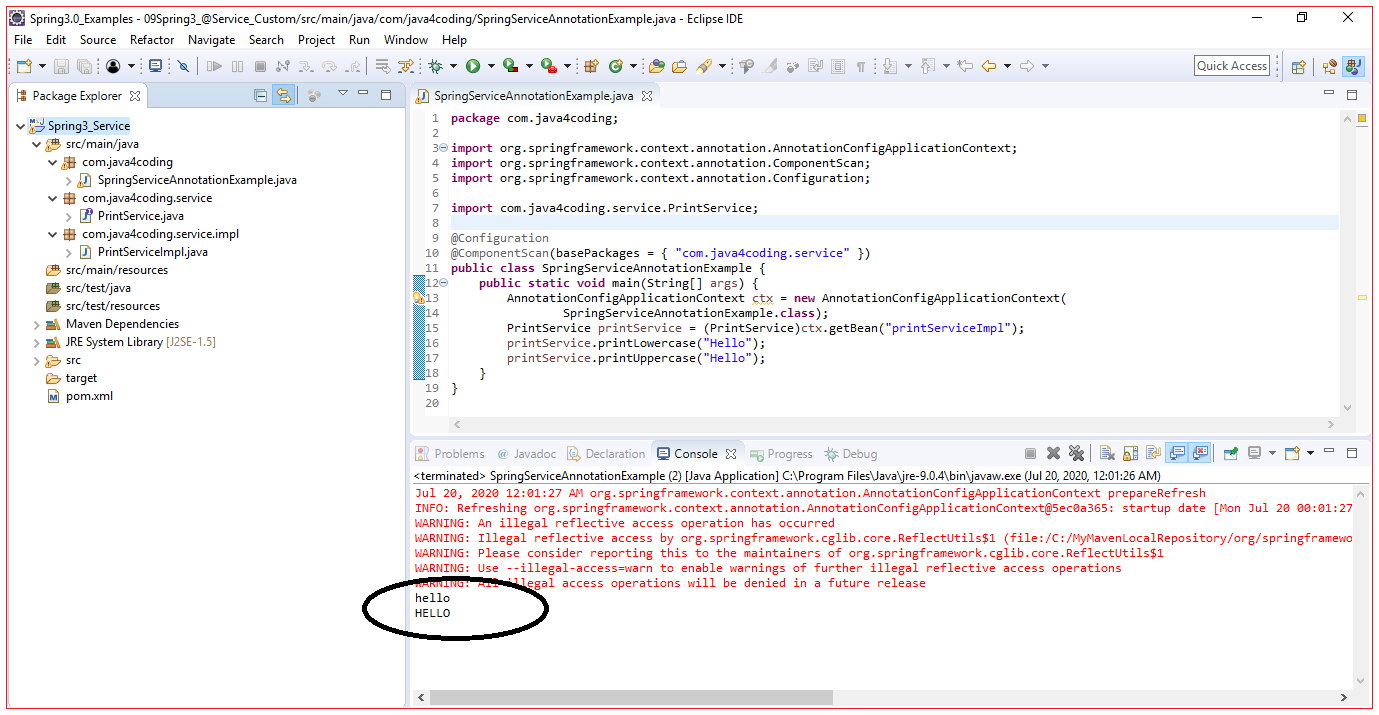| ☰ See All Chapters |
Spring @Service Annotation
@Service annotation can be called as specialized form of @Component annotation. By annotating a class with @Service annotation we indicate that a class is a "Business Service Facade" (in the Core J2EE patterns sense), or something similar. There is no any other specialty from @Component annotation except using it in the service layer.
Let’s create a simple spring application where we use @Service annotation.
Spring @Service Annotation Example
pom.xml
<project xmlns="https://maven.apache.org/POM/4.0.0" xmlns:xsi="https://www.w3.org/2001/XMLSchema-instance" xsi:schemaLocation="https://maven.apache.org/POM/4.0.0 https://maven.apache.org/xsd/maven-4.0.0.xsd"> <modelVersion>4.0.0</modelVersion> <groupId>com.java4coding</groupId> <artifactId>Spring3_Service</artifactId> <version>0.0.1-SNAPSHOT</version>
<dependencies> <dependency> <groupId>org.springframework</groupId> <artifactId>spring-core</artifactId> <version>${spring.version}</version> </dependency> <dependency> <groupId>org.springframework</groupId> <artifactId>spring-context</artifactId> <version>${spring.version}</version> </dependency> <dependency> <groupId>org.springframework</groupId> <artifactId>spring-aspects</artifactId> <version>${spring.version}</version> </dependency> </dependencies>
<properties> <spring.version>4.2.4.RELEASE</spring.version> </properties>
</project> |
PrintService.java
package com.java4coding.service;
public interface PrintService {
public abstract void printUppercase(String s);
public abstract void printLowercase(String s); } |
PrintServiceImpl.java
package com.java4coding.service.impl;
import org.springframework.stereotype.Service; import com.java4coding.service.PrintService;
@Service public class PrintServiceImpl implements PrintService {
public void printUppercase(String s) { System.out.println(s.toUpperCase()); }
public void printLowercase(String s) { System.out.println(s.toLowerCase()); } } |
SpringServiceAnnotationExample.java
package com.java4coding;
import org.springframework.context.annotation.AnnotationConfigApplicationContext; import org.springframework.context.annotation.ComponentScan; import org.springframework.context.annotation.Configuration;
import com.java4coding.service.PrintService;
@Configuration @ComponentScan(basePackages = { "com.java4coding.service" }) public class SpringServiceAnnotationExample { public static void main(String[] args) { AnnotationConfigApplicationContext ctx = new AnnotationConfigApplicationContext( SpringServiceAnnotationExample.class); PrintService printService = (PrintService)ctx.getBean("printServiceImpl"); printService.printLowercase("Hello"); printService.printUppercase("Hello"); } } |
Output:

All Chapters

